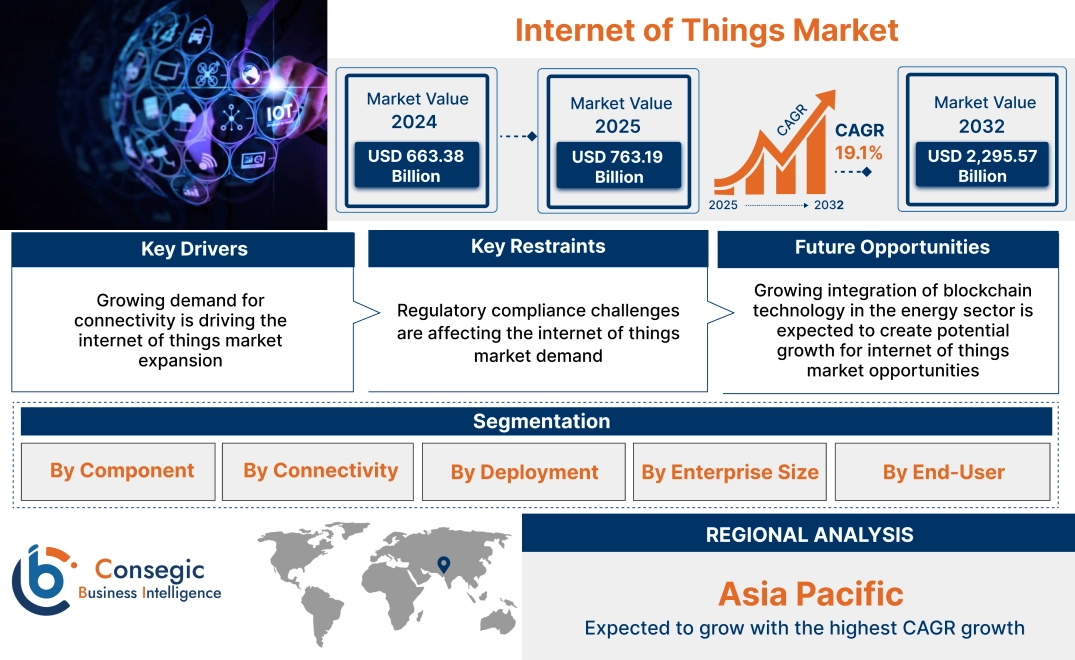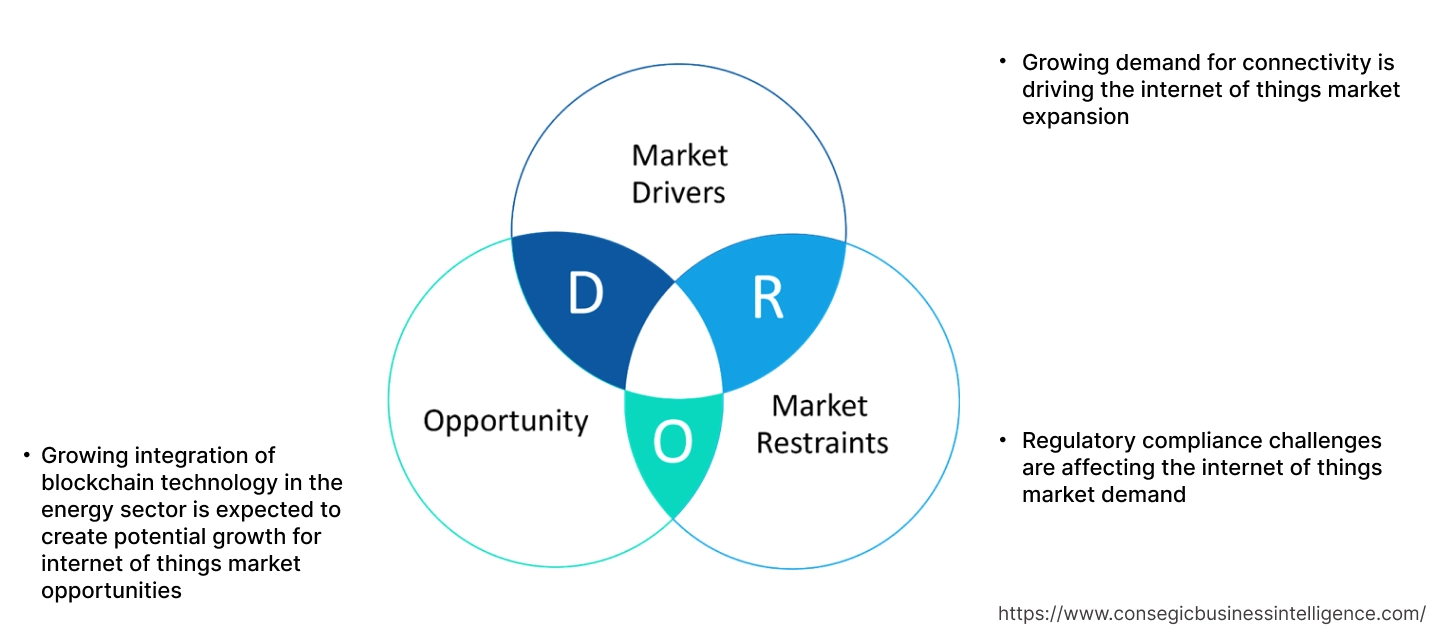- Summary
- Table Of Content
- Methodology
Internet of Things Market Size:
Internet of Things Market Size is estimated to reach over USD 2,295.57 Billion by 2032 from a value of USD 663.38 Billion in 2024 and is projected to grow by USD 763.19 Billion in 2025, growing at a CAGR of 19.1% from 2025 to 2032.
Internet of Things Market Scope & Overview:
Internet of things (IoT) refers to the system of physical devices, appliances, vehicles, and other objects integrated with sensors, software, and network connectivity. This interconnection enables devices to collect, transmit, and analyze vast amounts of data, fostering smarter decision-making and operational efficiencies across various sectors. Businesses are leveraging IoT to optimize processes, improve resource allocation, and enhance customer experience. Further, government initiatives and supportive policies are also playing a crucial role, encouraging investments in IoT infrastructure and fostering a conducive regulatory environment for market development.
Key Drivers:
Growing demand for connectivity is driving the internet of things market expansion
With the proliferation of connected devices and sensors in industrial environments, there is a growing emphasis on establishing strong connectivity infrastructure to enable real-time data exchange and analysis. Companies are increasingly investing in advanced networking technologies such as 5G, LPWAN (Low Power Wide Area Network), and edge computing to facilitate high-speed, low-latency communication, enhancing operational efficiency and decision-making processes.
Further, the rising adoption of industrial internet of things (IIoT) is fueled by the benefits of connectivity, including enhanced automation, predictive maintenance, and supply chain optimization. Connectivity enables the creation of interconnected systems that can adapt and respond dynamically to changing operational conditions, leading to improved productivity, cost savings, and innovation across industries. As industries continue to embrace digital transformation and Industry 4.0 initiatives, the need for better connectivity solutions within the IIoT ecosystem is expected to grow exponentially.
- For instance, in March 2025, Honeywell announced that the company’s smart meters will be equipped with Verizon’s 5G connectivity, to allow both users and utilities to remotely access critical data and manage energy usage. By leveraging AI, cloud, IoT, and 5G, the company’s smart meters will offer utility companies with secure and reliable network, while capable of sending information about grid connections and equipment performance.
Thus, according to the internet of things market analysis, the growing adoption of smart devices in industrial sector is driving the internet of things market size and trends.
Key Restraints:
Regulatory compliance challenges are affecting the internet of things market demand
As IoT technologies integrate deeply with energy infrastructures, they must adhere to various local, national, and international standards. These regulations cover a broad spectrum of concerns, including data privacy, cybersecurity, environmental impact, and operational safety. Data privacy and cybersecurity regulations are particularly challenging for IoT in several sectors. Further, regulations such as the General Data Protection Regulation (GDPR) in Europe set high standards for data privacy, imposing strict guidelines on how data is collected, stored, and shared.
In addition to this, compliance requires robust data management strategies and advanced security measures to protect against breaches and unauthorized access. Thus, the above analysis depicts that the aforementioned factors would further impact on the internet of things market size.
Future Opportunities:
Growing integration of blockchain technology in the energy sector is expected to create potential growth for internet of things market opportunities
By utilizing blockchain, energy companies can streamline processes such as energy trading, grid management, and compliance with regulatory requirements. This level of transparency and security helps mitigate fraud and errors. Moreover, blockchain facilitates peer-to-peer energy trading among consumers, enabling a more decentralized energy market. With IoT devices such as smart meters and sensors, consumers can track their energy production and consumption in real-time. Blockchain technology securely records these transactions, allowing consumers to sell excess energy directly to their neighbors or back to the grid without the need for intermediaries. This not only empowers consumers but also promotes the use of renewable energy sources by making it easier and more profitable for individuals to generate and sell their own energy.
- For instance, in March 2025, Siemens’ Cre8Ventures announced the partnership with Minima Blockchain, to bring AI capabilities, data integrity, and decentralised mechanisms for digital twin segment. With this partnership, the companies will address critical unmet needs in the energy and other sectors. Minima’s embedded blockchain can enable IoT equipment to eliminate all central points of failure and ensure full security and data integrity.
Thus, based on the above internet of things market analysis, the growing integration of blockchain technology in the energy sector is expected to drive the internet of things market opportunities and trends.
Internet of Things Market Segmental Analysis :
By Component:
Based on component, the market is segmented into platform and solution & services.
Trends in the component:
- Software solutions enable companies to optimize operations, enhance energy efficiency, and make informed decisions based on real-time insights.
- Solutions such as remote monitoring, data management, analytics, and security solutions are at the forefront, enabling industries to optimize operations, enhance productivity, and ensure safety.
- Thus, the above factors are driving the internet of things market demand.
The platform segment accounted for the largest revenue in the year 2024.
- Platforms serve as the foundational technology that connects various IoT devices, facilitating the seamless integration and management of data generated across several industries.
- Platforms provide the necessary infrastructure for data collection, storage, and analysis, enabling real-time monitoring and control of systems.
- They support functionalities such as device management, data integration, and analytics, which are essential for the effective deployment and operation of IoT solutions in the various sectors.
- For instance, in September 2024, Zoho launched customizable low-code IoT platform, which enable businesses and install custom IoT solutions. It provides businesses with actionable insights and enhanced operational analysis with seamless management of IoT device data in real time.
- Thus, the aforementioned factors are further driving the internet of things market growth.
The solution & services segment are anticipated to register the fastest CAGR during the forecast period.
- Solutions such as predictive maintenance utilize IoT data to anticipate equipment failures and schedule timely repairs, thereby, reducing downtime and maintenance costs. These solutions are critical for improving operational efficiency, enhancing sustainability, and reducing operational costs.
- For instance, in October 2022, Du, a subsidiary of Emirates Integrated Telecommunications Company (EITC), announced the partnership with Huawei and SINOTRANS to introduce 5G-driven robot warehouse solutions. This Memorandum of Understanding (MoU) was signed at GITEX Global 2022, underscoring Du's commitment to innovation and its role in advancing technological capabilities within the Emirates. The initiative aims to leverage technologies such as IoT, augmented reality (AR), metaverse, blockchain, non-fungible tokens (NFTs), and robotics to shape the future of logistics and enhance operational efficiency.
- Consulting services help companies develop IoT strategies, design architectures, and select the right technologies.
- Additionally, system integration services ensure that various IoT devices and solutions work together seamlessly within existing infrastructure.
- Thus, the above trends are expected to drive the internet of things market share and growth during the forecast period.
By Connectivity:
Based on connectivity, the internet of things market is segmented into zigbee, Wi-Fi, Bluetooth, Z-wave, and others.
Trends in the connectivity:
- As IoT adoption accelerates across industries, from smart manufacturing and healthcare to transportation and agriculture, the need for reliable, efficient, and scalable connectivity solutions has surged. IoT connectivity enables devices to transmit data in real-time, empowering businesses and organizations to make informed decisions, automate processes, and improve operational efficiencies.
- Connectivity ICs (Integrated Circuits) are fundamental in enabling IoT devices to communicate and connect to networks securely. With the proliferation of wireless technologies like Bluetooth, Wi-Fi, and cellular networks, the demand for robust, low-power connectivity solutions is escalating. Manufacturers are developing specialized ICs to meet these needs, enhancing device interoperability and network reliability in diverse IoT ecosystems.
The Wi-Fi segment accounted for the largest revenue share of 40.84% in the year 2024.
- The advent of IoT technology has led to a surge in connected devices and sensors that rely on Wi-Fi connectivity for data transmission and communication.
- Innovations such as Wi-Fi mesh networks, Wi-Fi 6E (which utilizes the 6 GHz frequency band), and Wi-Fi 7 (which is in development phase) are further enhancing the Wi-Fi capabilities and address emerging use cases such as ultra-low latency applications and dense IoT deployments.
- With the proliferation of IoT applications in areas such as smart homes, smart cities, healthcare, agriculture, and industrial automation, the demand for Wi-Fi networks capable of supporting large numbers of connected devices continues to rise. Wi-Fi provides the flexibility, scalability, and bandwidth required to connect diverse internet of things sensors, actuators, and control systems, facilitating real-time monitoring, analytics, and control of physical assets and environments.
- For instance, in August 2022, Nordic Semiconductor announced the release of Wi-Fi chip, which is designed for ultra-low power IoT devices such as sensors. This will leverage company’s strong market position in highly competitive market.
- Therefore, the above factors would further supplement the internet of things market
The zigbee segment is anticipated to register the fastest CAGR during the forecast period.
- Industrial automation, driven by technologies like zigbee, is transforming manufacturing processes worldwide. Zigbee's role in industrial automation lies in its ability to create robust and scalable wireless networks that facilitate seamless communication between machines, sensors, and control systems.
- In consumer wearable devices, such as smartwatches, fitness trackers, and smart clothing, zigbee enables seamless connectivity between sensors, actuators, and mobile devices. Its low-energy consumption prolongs battery life, crucial for enhancing user convenience and device usability.
- For instance, in June 2024, Trident IoT launched new zigbee chip and software development kit (SDK). This launch further boost the company’s IoT developments by expanding product portfolio in zigbee and Z-wave offerings.
- These developments in the zigbee segment are anticipated to further drive the internet of things market trends during the forecast period.
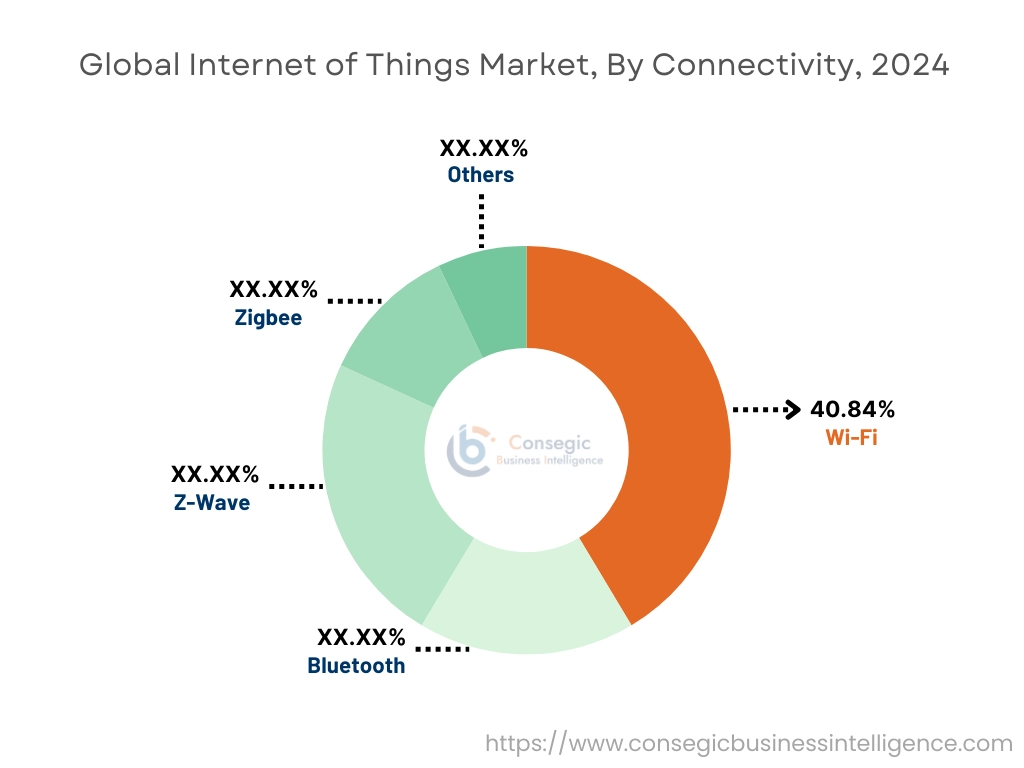
By Deployment:
Based on deployment, the internet of things market is segmented into cloud and on premise.
Trends in the deployment:
- On-premise and cloud platforms play a pivotal role in bridging the gap between physical devices and digital systems, enabling enterprises to extract actionable insights, optimize processes, and deliver personalized user experiences.
- The growing adoption of IoT solutions, particularly in sectors such as automotive and manufacturing, for real-time data processing and improved operational efficiency, are driving the need for on-premise and cloud deployments.
The on-premise segment accounted for the largest revenue in the year 2024.
- On-premise deployment involves the installation of IoT solutions and infrastructure within the organizations’ physical premises, giving the full control over their data and operations.
- This approach is preferred by all types of enterprises who require high levels of security and customization in their systems.
- For instance, UbiBot, an on-premise IoT platform, supports enterprise intranet management with high stability and better performance. The platform supports local LAN deployment, historical data review, and local data storage.
- Thus, based on the above analysis, these factors are driving the internet of things market growth.
The cloud segment is anticipated to register the fastest CAGR during the forecast period.
- Cloud deployment offers organizations greater scalability, flexibility, and cost-effectiveness, as they can quickly scale resources up or down based on demand, pay only for what they use, and benefit from automatic updates and maintenance provided by cloud service providers.
- Cloud solutions also enable remote access, collaboration, and data sharing among distributed teams, making them well-suited for modern workplace environments, and remote work scenarios.
- Moreover, cloud deployment facilitates faster time-to-market for new digital initiatives, as organizations can leverage pre-built software solutions and development platforms offered by cloud providers, reducing the need for extensive in-house development and customization efforts.
- For instance, Microsoft offers Microsoft Azure IoT, which includes a collection of managed-cloud services and edge components that connect, monitor and control IoT devices and assets at scale.
- These factors are anticipated to further drive the internet of things market trends during the forecast period.
By Enterprise Size:
Based on enterprise size, the internet of things market is segmented into SMEs and large enterprise.
Trends in the enterprise size:
- Subscription-based models are gaining traction, allowing companies to access IoT solutions through flexible subscription plans rather than making substantial upfront investments. This approach provides access to IoT technologies, for small and large enterprises, while providing recurring revenue streams for providers.
- Collaborative ecosystems are emerging, where multiple stakeholders collaborate to deliver comprehensive IoT solutions, leveraging each other's strengths to create synergies and address complex industrial challenges.
The large enterprise segment accounted for the largest revenue share in the year 2024.
- Large enterprises encompass organizations with substantial resources, extensive operations, and a significant customer base. These enterprises leverage digital intelligence platforms to manage complex data ecosystems, derive actionable insights from vast amounts of information, and enhance decision-making processes across multiple departments.
- These organizations have the financial means and internal expertise to invest in cutting-edge technologies, such as artificial intelligence, cloud computing, and IoT, to drive innovation, improve operational efficiency, and enhance customer experiences.
- Large enterprises leverage digital transformation to streamline business processes, optimize supply chain operations, and foster a culture of continuous innovation and agility, enabling them to maintain their market leadership positions and adapt to changing market dynamics effectively.
- Thus, based on the above factors, these developments in the large enterprises segment are driving the global market.
The SMEs segment is anticipated to register the fastest CAGR during the forecast period.
- Small and medium-sized enterprises (SMEs) are increasingly adopting digital intelligence platforms to stay competitive and enhance their customer engagement capabilities.
- SMEs are focusing on integrating advanced analytics and optimization strategies to harness the full potential of digital intelligence tools, leading to market expansion across various industries.
- IoT connectivity enables SMEs to leverage real-time data insights for process optimization, inventory management, and customer engagement, driving operational efficiency and competitive advantage in their respective markets.
- These factors are anticipated to further drive the global market during the forecast period
By End User:
Based on end user, the internet of things market is segmented into agriculture, banking, financial services and insurance (BFSI), government, healthcare, IT & telecom, manufacturing, retail, sustainable energy, transportation, and others.
Trends in the end user:
- As the retail sector embraces this paradigm shift, the IoT ecosystem grows, provide enhanced customer engagement, streamline operations, and a dynamic marketplace.
- Agriculture embraces IIoT for precision farming, crop monitoring, and livestock management, optimizing resource allocation and increasing agricultural productivity.
The manufacturing segment accounted for the largest revenue share in the year 2024.
- In manufacturing sector, IoT connectivity plays a crucial role in achieving Industry 4.0 objectives by enabling interconnected machines, automated processes, and predictive maintenance capabilities.
- IoT solutions in manufacturing facilitate real-time monitoring of equipment performance, enhance production efficiency, and support adaptive manufacturing strategies based on data-driven insights.
- This sector benefits from reduced downtime, improved product quality, and enhanced agility in responding to market demands.
- In manufacturing, digital transformation enables organizations to embrace smart manufacturing technologies such as IoT, robotics, and 3D printing to optimize production processes, improve product quality, and enable mass customization.
- For instance, in February 2025, Samsung Electronics Co. Ltd. unveiled that the organization has accomplished the end-to-end reduced capability (RedCap) trial over a 5G network with Hyundai Motor. This trial showcased the successful deployment of private 5G network, IoT devices, such as automated guided vehicles, in manufacturing sector.
- Thus, based on the above factors, these developments in the manufacturing segment are driving the global market.
The healthcare segment is anticipated to register the fastest CAGR during the forecast period.
- IoT technology in healthcare enables the seamless integration and interoperability of medical devices, sensors, wearables, and other healthcare equipment with healthcare information systems, electronic health records (EHRs), and cloud-based platforms. This connectivity allows for real-time monitoring, remote patient management, and data-driven decision-making, empowering healthcare providers to deliver more personalized, efficient, and effective care.
- By leveraging IoT technologies, healthcare providers can offer remote consultations, monitor patients' vital signs in real-time, and even predict potential health issues before they escalate. This not only improves access to care, particularly for underserved populations and those in remote areas but also enables proactive intervention, in turn leading to better health outcomes.
- For instance, in October 2022, GE Healthcare announced the partnership with AMC Health, to provide remote health monitoring to patients with chronic and post-acute care.
- These factors are anticipated to further drive the global market during the forecast period.
Regional Analysis:
The global market has been classified by region into North America, Europe, Asia-Pacific, MEA, and Latin America.

Asia Pacific internet of things market expansion is estimated to reach over USD 608.56 billion by 2032 from a value of USD 168.39 billion in 2024 and is projected to grow by USD 194.45 billion in 2025. Out of this, the China market accounted for the maximum revenue split of 35.18%. Asia Pacific emerges as a rapidly growing market for internet of things, fueled by factors such as rapid urbanization, technological advancements, and increasing digital connectivity. Countries such as China, India, Japan, and Singapore are witnessing significant investments in digital infrastructure, digital literacy programs, and digital innovation hubs to accelerate IoT initiatives and drive economic growth. Further, Asia Pacific businesses are leveraging digital technologies to address challenges such as urbanization, sustainability, and social inclusion, while also seizing opportunities in emerging sectors such as e-commerce, fintech, and smart manufacturing. These factors would further drive the regional internet of things market during the forecast period.
- For instance, in October 2022, Tata Consultancy Services (TCS) announced the partnership with Microsoft, to build autonomous solutions with Project Bonsai, a low code and secure AI platform. It enables companies to modernize their manufacturing operations, reduce downtime, and enhance quality and throughput.
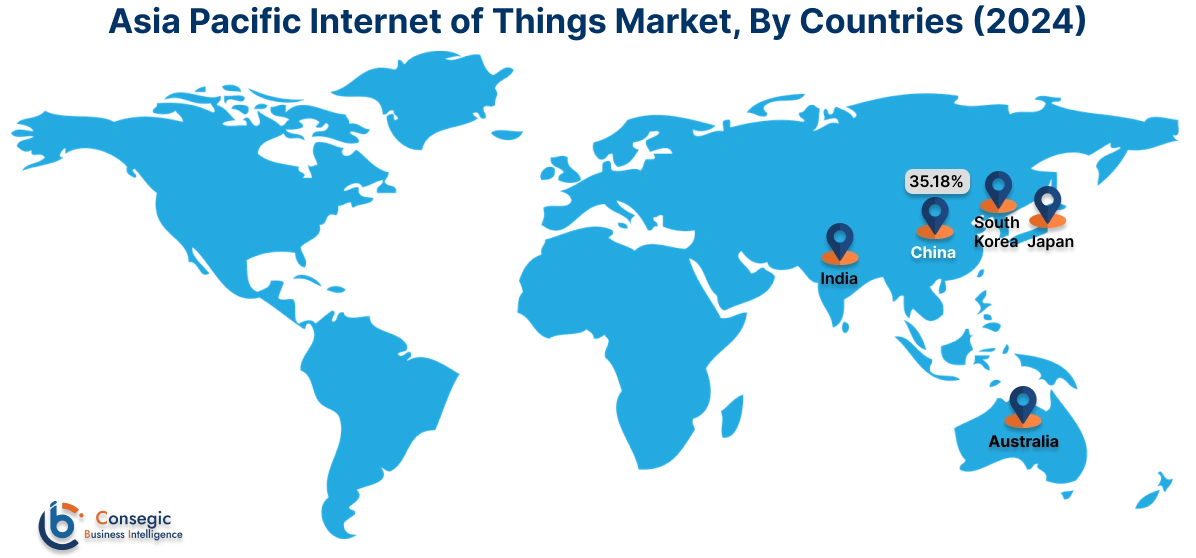
North America market is estimated to reach over USD 829.85 billion by 2032 from a value of USD 240.93 billion in 2024 and is projected to grow by USD 277.07 billion in 2025. North America stands as a leading region in the global market, driven by a strong technological infrastructure, a robust startup ecosystem, and high levels of digital maturity across industries. Countries such as the United States and Canada are the forefront of digital innovation, with businesses investing in advanced technologies such as cloud computing, artificial intelligence, and IoT to drive innovation, improve operational efficiency, and enhance customer experiences. Moreover, the region has a diverse range of digital transformation initiatives across sectors such as healthcare, retail, finance, and manufacturing, driving significant market growth. These factors would further drive the internet of things in the regional market.
- For instance, in February 2023, Cisco launched new cloud services within its IoT operations dashboard for industrial purposes. This launch aims to increase visibility into manufacturing assets, offering secure and operational management capabilities from any location. The new cloud services also facilitate a better transition for industrial customers towards cloud automation.
Additionally, according to the analysis, the internet of things industry in Europe is projected to witness significant development during the forecast period. European countries prioritize sustainability and smart city initiatives, leveraging IoT to improve energy efficiency, transportation systems, and public services. The region's well-developed telecommunications infrastructure and initiatives promoting digital transformation contribute to widespread IoT adoption, particularly in industrial automation and smart grid applications.
Additionally, countries within Latin America prioritize initiatives that enhance energy efficiency, reduce carbon emissions, and improve urban mobility using IoT technologies. Smart buildings equipped with IoT sensors for energy management and smart grids optimizing renewable energy integration are prominent examples of IoT applications in Latin America smart cities. Further, the Middel East & Africa (MEA) regional growth can be attributed to the increasing investments in IoT projects across sectors such as energy, utilities, and transportation, driven by urbanization and infrastructure development. As organizations in these regions seek to utilize the benefits of IoT while addressing cybersecurity challenges, the adoption of identity and access management solutions becomes crucial to ensure data integrity, regulatory compliance, and operational resilience.
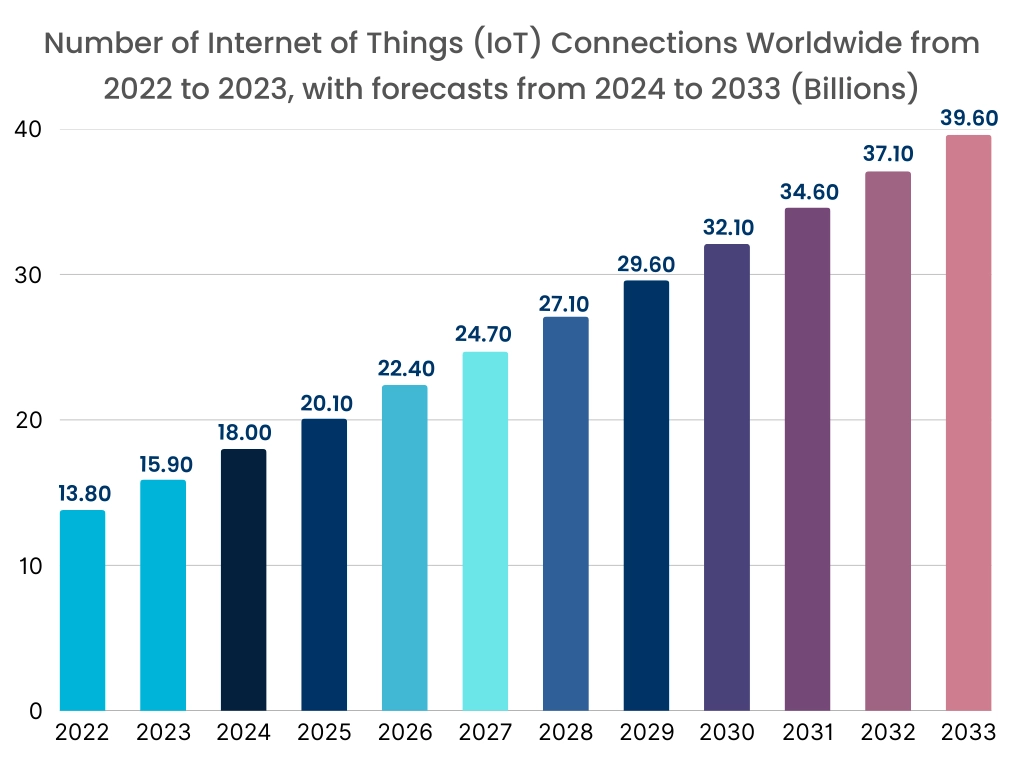
Top Key Players & Market Share Insights:
The global internet of things market is highly competitive with major players providing solutions to the national and international markets. Key players are adopting several strategies in research and development (R&D), product innovation, and end-user launches to hold a strong position in the market. Key players in the internet of things industry include-
- Amazon Web Services, Inc. (U.S.)
- Cisco Systems, Inc. (U.S.)
- PTC Inc. (U.S.)
- SAP SE (Germany)
- Siemens AG (Germany)
- GE (U.S.)
- IBM Corporation (U.S.)
- Intel Corporation (U.S.)
- Microsoft Corporation (U.S.)
- Oracle Corporation (U.S.)
Recent Industry Developments :
Product Launch:
- In March 2024, Qualcomm launched an ultra-low-power Wi-Fi SoC, the QCC730, designed to improve battery efficiency for IoT devices. The chip boasts 88% lower power consumption than previous models.
Internet of Things Market Report Insights:
| Report Attributes | Report Details |
| Study Timeline | 2019-2032 |
| Market Size in 2032 | USD 2,295.57 Billion |
| CAGR (2025-2032) | 19.1% |
| By Component |
|
| By Connectivity |
|
| By Deployment |
|
| By Enterprise Size |
|
| By End-User |
|
| By Region |
|
| Key Players |
|
| North America | U.S. Canada Mexico |
| Europe | U.K. Germany France Spain Italy Russia Benelux Rest of Europe |
| APAC | China South Korea Japan India Australia ASEAN Rest of Asia-Pacific |
| Middle East and Africa | GCC Turkey South Africa Rest of MEA |
| LATAM | Brazil Argentina Chile Rest of LATAM |
| Report Coverage |
|
Key Questions Answered in the Report
How big is the Internet of Things Market? +
Internet of Things Market Size is estimated to reach over USD 2,295.57 Billion by 2032 from a value of USD 663.38 Billion in 2024 and is projected to grow by USD 763.19 Billion in 2025, growing at a CAGR of 19.1% from 2025 to 2032.
Which is the fastest-growing region in the Internet of Things Market? +
Asia-Pacific is the region experiencing the most rapid growth in the market.
What specific segmentation details are covered in the Internet of Things report? +
The Internet of Things report includes specific segmentation details for component, connectivity, deployment, enterprise size, end user, and region.
Who are the major players in the Internet of Things Market? +
The key participants in the market are Amazon Web Services, Inc. (U.S.), Cisco Systems, Inc. (U.S.), GE (U.S.), IBM Corporation (U.S.), Intel Corporation (U.S.), Microsoft Corporation (U.S.), Oracle Corporation (U.S.), PTC Inc. (U.S.), SAP SE (Germany), Siemens AG (Germany), and others.
